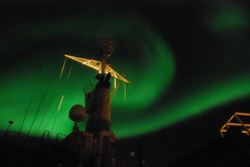Night Show by Dallas Murphy
The Northern Lights have seen queer sights, “Maybe tonight,” we’d say if even the faintest hint of sky peeked through the evening murk, which it did only rarely since we left Iceland. But every night the clouds closed in and the sky went pitch black. Until October 21. We’d been steaming all day along the east coast of Greenland gaping at the mountains and squinting into bright light. “What’s that?” someone wondered. “That bright yellow thing, you mean?” “Yeah.” “I read about it somewhere. The Polynesians call it the Sun.” “Maybe tonight.” The sky was cloudless. The “Pointers” on the cup of the Big dipper showed the way, beyond the brim, to Polaris directly overhead, the first stars we’d seen in three weeks. We waited. About 9:00pm (2100), I noticed my shipmates in the main lab hurrying into heavy coats, pulling hats down around their ears, and I didn’t need to ask why. The Northern Lights. Aurora Borealis. A great ribbon of blue arced from the horizon astern, spanned the stack and the orbiting radar receiver and dipped to the far horizon. It shimmered and undulated, and we watched delightedly, never mind the steel-cold wind as we tried to maintain our balance on the rolling deck. Tonight, definitely tonight. To the Inuit, the lights were the spirits of the yet-unborn signaling to the living from the great beyond. To the Algonquin of northern Canada, the lights were their ancestors dancing around a ceremonial fire. When the lights shimmer and ripple, said the Eskimo, their friends and relatives who have gone to the sky are reminding the living of their presence. Prospectors during the Alaskan Gold Rush knew for sure that the lights were reflections from the mother lode. The Romans gave the Lights their name—Aurora for the goddess of dawn and Borealis for the north wind. To scientists the Aurora is “solar wind.” The Sun emits energy-charged particles—ions—that soar out into space at 300 to 1,200 kilometers per second. A cloud of such particles is known as a plasma, and the stream of plasma from the sun is called solar wind. As they interact with the edge of Earth’s magnetic field, some of the particles are trapped in the solar wind, driven to follow the lines of Earth’s magnetic field down into the ionosphere some 60 to 600 kilometers above Earth’s surface. When the particles collide with the gasses in the ionosphere, they begin to glow: the Northern Lights. The blue ribbon of light jinked and swerved, went green for a time then back to blue, and beaded curtains of light unfolded from the bottom and retracted, dancing ancestors about the campfire, as the end of the ribbon rolled back on itself, then straightened and repeated the performance. But this may be one of those sights that bears out the old cliché about pictures and a thousand words, so I’ll let my shipmates’ photographs tell the rest of the story. But here’s an interesting aspect to consider. Earth scientists such as Dr. Bob first observe nature and then seek to explain it with the aid of electronic technology. So did the Inuit but without such aids. The two views of nature cannot be reconciled one against the other. There are no unborn spirits in the ionosphere; instead, there are ions and plasma and magnetic fields, but that does not diminish the beauty or the thrill or the wonder while watching Aurora Borealis perform for us on a cold, clear night in the Irminger Sea aboard this ship named Knorr. And the two views of nature can rest peacefully beside each other, like the present rests beside the past, each with its different kind of beauty. Anorersuaq by Nick M?llerUllup aallartinnera eqqissisimanartumik orfaanata pisarnititut suliassat umiarsuarmi ingerlapput, ippassaammat silasiortut ilimasaarinerat anorersuaq aggersoq sumiiffitigullu ingerlaartussaasoq eqqaavara. Titarniusaq sanimukartoq 68° titarniusarlu ammukartoq 20° toraarlugit avannamut ingerlarujoorpugut, illisimatuut ittuiat Bob Pickart paasiniaanermini DMI-mut aammalu Islandimi imarsiornermut akisussaasoqarfimmut, ersarissivoq anorersuaq 80 km/t sakkortussuseralugu supoorissasoq. Aallarsimalerluta silarlussioratta anoraa taamak sakkortigiginngilaq, taamanikkullu umiarsuarmi sulineq tamarmi uniusaqqavoq. Silalu qatsormat aallarsimalerluta qallukkagut ”Mooring” arsaarasarsuit sungaartumik qalipaatillit, ilaat ataaseq qularnaaqutiminiit kaanngarluni umiarsuup qaavani assakaalaarattaarsimavoq. Arlalitigut umiarsuup qaavani atortut singatitersimapput, containererlu assakaalaarfigalugu aporfigisarsimasaa najunngarsimallugu annertuumik. Aqaguanilu qaammarmat ”Mooring” arsaasarsuaq sungaartoq assakaalluni umiarsuup aquatigut aaliangeruteqanngitsukkut nakkarsimasoq tusarparput, arsaasarsuarlu ataaseq 10.000.$ tikillugit naleqarpoq. Kingorna arsaasarsuaq takoqqinngilarput, sumerpiarmi katannerlutigu ilisimagaluarutiguluunniit imaaliallaannaq nanisinnaanavianngilarput. Taamak pisoqaqqinnginnissaa pinaveersaartinniarlutigu, umiarsuup naalaga ilisimasassarsiortulli ittuat oqaloqatigiiluareerlutik aaliangiuppaat, Island-ip kangerluppassuisa ilaat oqquuffigiartorniarlutigu. Tassani kangerlummi qeqertaq toqqorsimaarfigissavarput, immaqalu ullut marluk missarluinnaani silarlumnmiit qimaaqqassalluta. Paasiniaanerminni Island-imut siunnersorneqarsimapput silarlutillugu qeqartaq umiartortunit atorluarneqartartoq, silapilummik nalaassisoqartillugu. Misissuinissamut pilersaarutit allannguuteqangaatsiarput, massakkumut piffissaarutilereerluta nalunarsivoq qanoq misissuinerit pitsaasumik ingerlateqqissinnaassanerlutigit. Ippassarmi aaliangiusimavarput Island-p avannaatungaani misissuinerit ingerlanniarlutigit, naak siuliani Tunup sineriaani misissuinerit ingerlannissaanik siunniussinikuugaluarluta. Tamanna sikulersimaneranik pissuteqarluta Island-p avannaatungaanut misissuinerit allanngortinneqarput, malittuinnarmilli pilersaarutit allanngortitat allanngorteqqinneqarlutik. Massakkullu misissuinerit unitikkallarlugit Island-imi oqquusimaaginnartariaqarpugut, illuatungaatigulli inuttanit tamanna ajorineqanngilaq. Island qanillillugu takusussanngorparput, tamanna aallaqqaaratta arlaannattaluunniit sinnattorisimanngikkaluarpa, angalanerulli siunertaanut tamanna ajoraluartumik annertunngikkaluamik innarliivoq. Taamaammat umiarsuarmi upalungaarsimanissaq pingaaruteqarpoq, aqagumi ulloq qanoq ikkumaarnersoq ilisimaneqangilaq, silasiortulli siuttuupput taakkumi ilimasaarutigaat anorersuarumaartoq. Allalli aqagu susoqarumaarneranik eqqoriaaginnartarput pilersaarusiorlutillu, amerlanertigut pilersaarutit eqquuttarput, kisiat qularnaarlugu oqartoqarsinnaanngilaq ilumut kissaatigisaq naapertorlugu pisoqarumaartoq. Soqutiginarluartummi piffiit ilaat ornillugit misissuivigerusukkaluaqaagut, paasisammi annertunerulerpata ilisimasat atorsinaasut apeqqutillu akineqarsinnaasut annertunerulissagaluarmata. Silami kisimi nalagaavoq, silallu atugassarititai malillugit misissuinerput ingerlattariaqarparput. Pilersaarutit naapertorlugit aqagu ullaap tungaani Island tikissimalertussassavarput, tunutinnilu anorlilereersimanera malugisinnaavarput. Pissanganarpoq aqagu ullaakkut nuna qanoq ittoq takujumaarnerlutigu, neriuppugullu unnuamut silarlummut angumeritippallaassanata. Last updated: October 22, 2008 | |||||||||||||||||||
Copyright ©2007 Woods Hole Oceanographic Institution, All Rights Reserved, Privacy Policy. | |||||||||||||||||||

